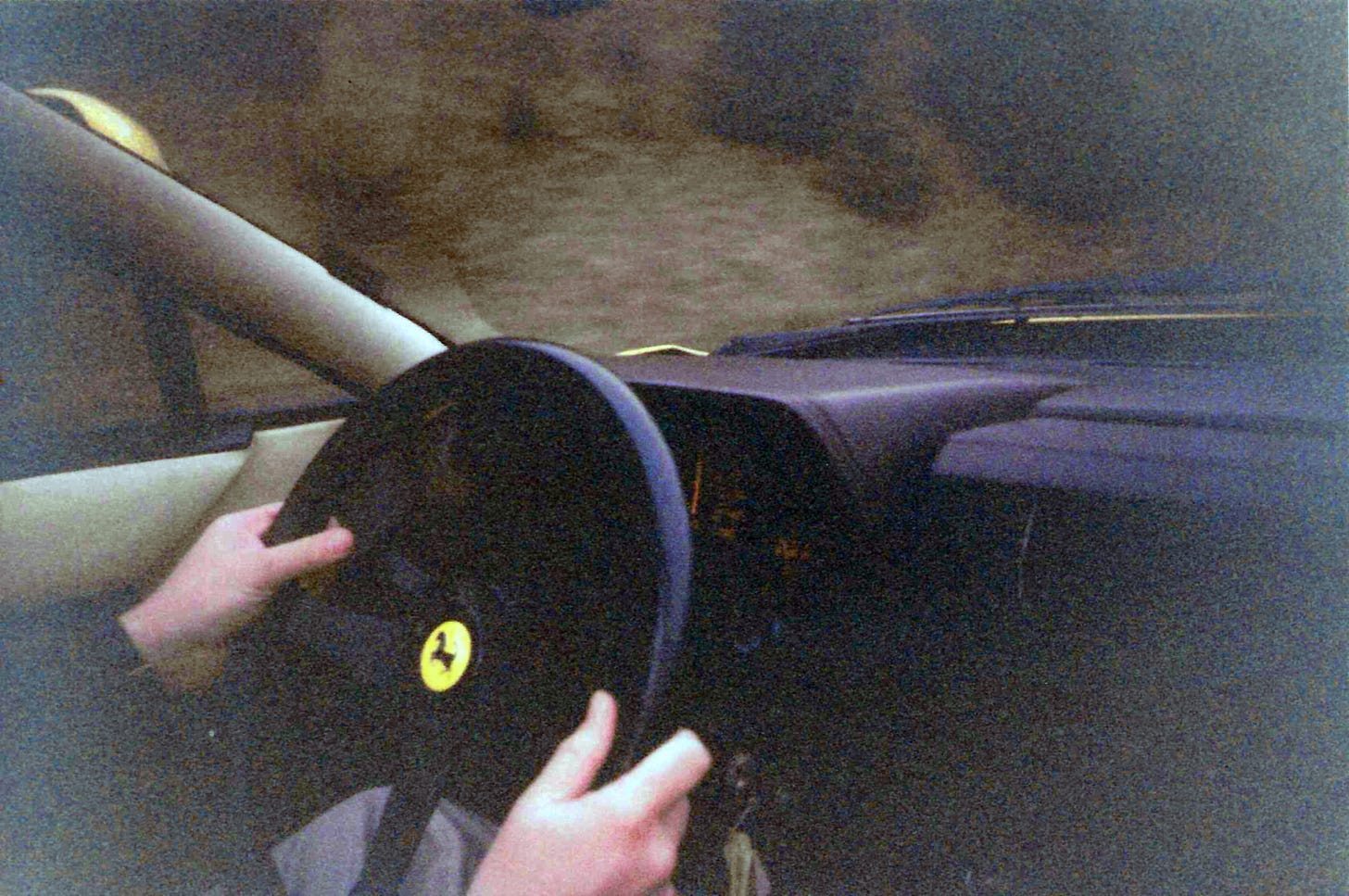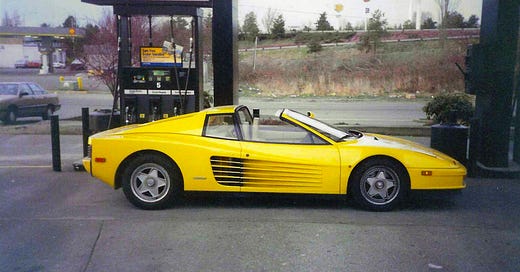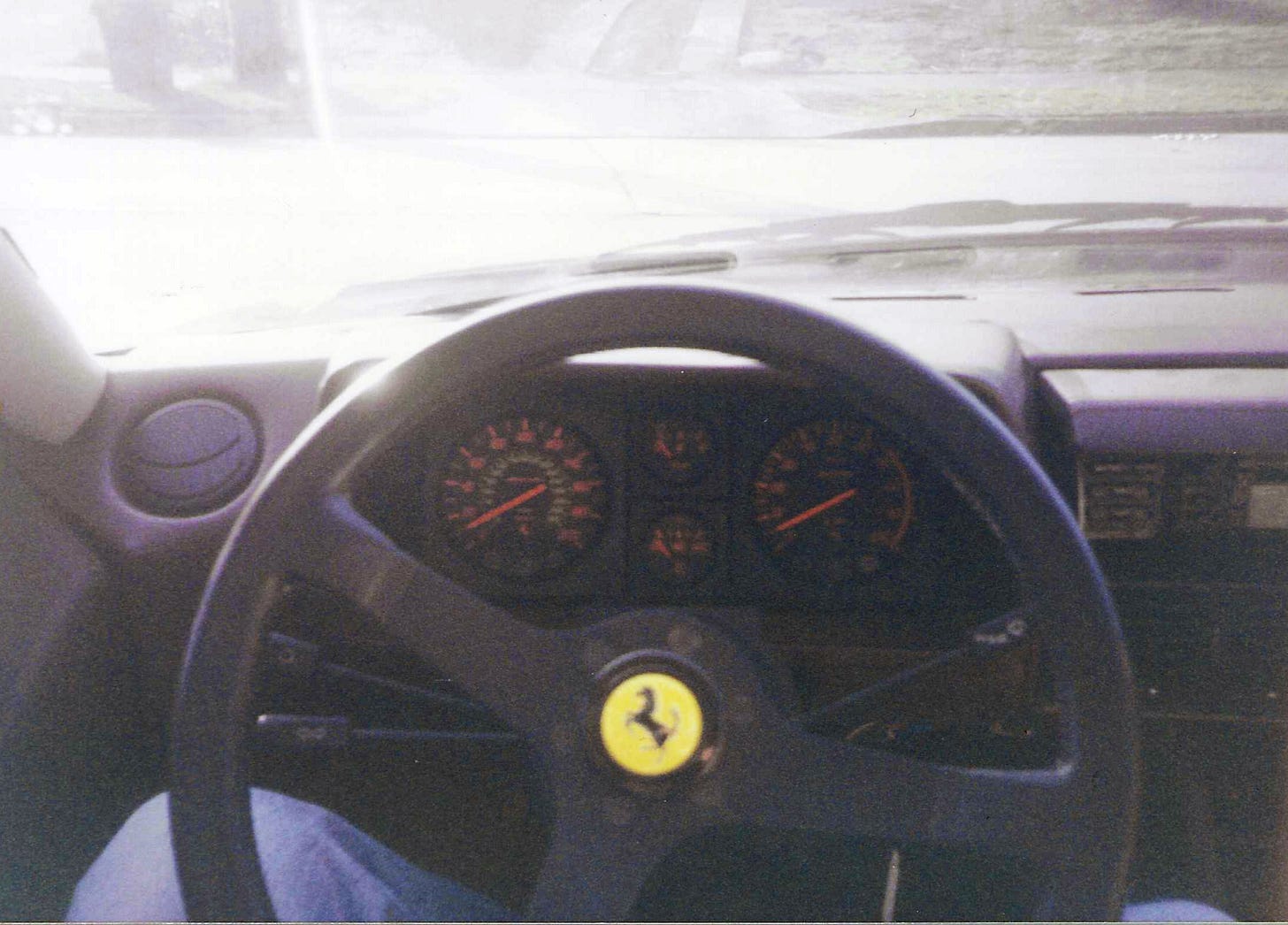Road Tripping over The Border in The Boss'1985 Ferrari Testarossa EBS Targa
Iconic Ferrari serving as featured lot in Bohnam's Miami auction event redlines the nostalgia for an unforgettable mid-90's road trip.
One of the thanks I get for years of service as an automotive journalist and collector vehicle dealer is a daily Niagara Falls-scale deluge of emails from seemingly every car-related business on planet Earth. Most go directly into the Trash folder, but a few weeks ago an email promoting a featured car in Bonham’s upcoming “The Miami Auction” event caught my eye and threw my brain into a nostalgic tizzy. The email spotlighted the totally restored one-of-one ever made 1985 Ferrari Testarossa Targa by EBS in classic Fly Yellow paint.
It was the first Ferrari I ever drove.
On a temperate early summer day in 1995, I was a less gray-haired twenty-something product marketing manager for a Seattle-based telecommunications company preparing to drive my 1991 Chrysler LeBaron Convertible nearly four-hours to attend an industry trade show in Vancouver, British Columbia. My good friend, Marcos, a cellular services entrepreneur and son-in-law of the CEO of the company for which I worked, decided not only should we ride together, but we should instead take my boss’ 1985 Ferrari Testarossa. Within minutes he had phoned his father-in-law to obtain permission and we were on our way to emancipate the Ferrari from the boss’ home garage.
Testa Rossa was the name given to Enzo Ferrari’s red cam cover-adorned legendary front-engine three-liter V12 production sports racers built from 1957 until 1961. The moniker reappeared in single word form in 1985 for the company’s newest exotic gran turismo road car, which was an extensively reworked evolution of the preceding mid-engine 365 and 512 Berlinetta Boxer models. With a sticker price of over $95,000 when new, a Testarossa carried a cost twenty percent higher than a contemporary median Seattle-area home.
Marcos raised the garage door at his father-in-law’s lakeside residence, exposing the Ferrari’s ultra-low and incomprehensibly wide body. Staring back directly at us was its unmistakable rectangular rear end affixed with the personalized Washington state license plate “976”, an explicit nod to the telephone chat line ventures from which its owner had made a substantial fortune. The Fly Yellow paint (a redundant title given “Fly” originated from an internal acronym for “Ferrari Light Yellow”) glowed gloriously despite being barely illuminated by a single hanging incandescent bulb dimmer than the average grunge band bass player.
Marcos reached in and twisted the key, energizing the starter to emit its mechanical whir for what seemed an eternity. Finally, the horizontally-opposed 4.943-liter twelve burst to life revealing an uneven and very concerning surging idle, a malady many Testarossa owners would later learn from online forums was one of the most common afflictions to the intertwined mass of Ferrari engine parts, Bosch KE-Jetronic fuel injection system components and notoriously brittle Marelli ignition electrics. For a moment we debated turning it off. Instead we concluded we should do the right thing: totally ignore the problem and drive it.
Being the only professionally created Targa from Belgian coachbuilder EBS, we seized the opportunity to reach through the open windows to unclip the two-piece targa top and stow it in the front luggage compartment, leaving just enough space in the voids for our two thin garment bags. Marcos asked if I wanted to drive first, so moments later I was grasping under the top of the signature cheese-grater side louvers to pull the driver’s door handle. Dropping down and crossing the wide sill, I wedged my body into the firm cream-colored leather sports seats. Orange on black gauges in square binnacles faced me as I grabbed the thick-rimmed Momo steering wheel. Seat travel seemed about four inches too short, leaving my 6’4” and 185-pound frame in the uncomfortable infamous “Italian ape” driving position with legs bent and arms out. My head also protruded awkwardly above the windshield frame top with the folded sun visor a mere few inches from my eyebrows.
As I put the long lever into reverse above the dogleg first gear of the metal shift gate, I recalled my boss mentioning just a month prior spending $6,000 to replace the clutch. Lifting my left foot with fear the clutch pedal might be tough to master, I was instantly surprised the very positive friction point and smooth action propelled the car softly and easily from rest. Shifting the cold transmission took a slow and heavy hand, but with each gearchange the box action seemed to improve.
Down the street a few blocks, I quickly got the hang of the surprisingly slow and rather heavy steering while traversing between the pothole minefields of South Seattle’s residential neighborhoods. I pulled across oncoming traffic to head into the gas station driveway. A crunch resonated throughout our spines as the low front valance slammed into the entryway lip. Marcos grit his teeth. An older male pedestrian cringed, stepped back and pleaded loudly for me to “take it easy with that pretty thing”. Luckily there was no damage evident among the numerous preexisting gouges from countless previous concrete impacts. I made a mental note to always approach at sharp angles and slow speed in the future.
After fueling I cautiously exited the station. Over the ten or so city blocks, while the Testarossa seemed “easy to drive”, it also felt big and cumbersome for what most considered a sports car. The poorly kept streets had the Ferrari juddering like an old farm truck on a rutted gravel road. The stylistically fabulous high-mounted side mirror offered great visibility on the driver’s side for merges to the left, but the lack of a passenger side mirror on this first-year 1985 model made lane right-side changes a head-rotating endeavor. Luckily, visibility through the rear window was spectacular compared to other exotics like the Lamborghini Countach. Still, this high performance GT was certainly not in its element in the slow narrow lanes of urban residential roads.
Turning onto the onramp to Interstate 5 going north everything changed. I planted the accelerator to the floor, prompting an escalating mechanical crescendo from the flat-twelve cylinder all the way up to its wailing 6,800 rpm redline. The transmission, finally coming up to temperature, delivered smoother shifts into each taller gear. Keeping pace with the flow near the legal limits in fifth gear, the Testarossa produced a smooth, effortless hum from behind our backs. Marcos and I just settled in to enjoy the midday sun and remarkably light traffic while racking up miles heading north.

With multiple counties in the rearview mirror and a long open stretch ahead, I rev-matched then downshifted from fifth to third and mashed the throttle. With a sensational howl from the exhaust, every one of its 380 ponies came alive. Even with over 3750 pounds to move, by pre-Google-era standards the Testarossa was a rocket. Able to reach triple digit speeds in twelve seconds and 180 mph flat-out, it was simply one of the quickest accelerating and fastest overall production vehicles most automotive publications had ever tested. Before I knew it, the speedometer was pointed straight up at the 100 mph mark. I didn’t possess the spine, skills or means to afford high risk insurance as justification for me to verify the top speed results achieved by previously published road tests.
The Testarossa’s suspension at 55 mph had indeed seemed more like it came from a five-yard dump truck and frustratingly conspired with the steeply raked windshield to slam my forehead into the folded sun visor when jarred by road imperfections and expansion joints. Despite some added chassis bracing, cutting the fixed roof obviously increased cowl shake on rough pavement at any velocity. At 100 mph, though, the stability was otherworldly with seemingly telepathic steering, the car knowing exactly where to go with each small input. High speed handling benefitted from its 77.8-inch width, among the widest production cars of the day. Still, fearing for my life and license, I decided to hit the brakes, which provided great feel and fade-free stopping power.
Upon reaching the US-Canada border crossing at Blaine, the smiling young Canadian woman border guard greeted us by complimenting the car. Noticing my head sticking prominently above the targa top opening, she then questioned if it was indeed actually my car. I replied asking if she knew of a place that rented bright yellow Ferraris. Undeterred, she asked how I drove the car in the rain. I pointed to all five-foot-six-inches of Marcos. She waved us through.
Despite being designed for cross-continental travel and already demonstrating some in-city shortcomings, the Testarossa still proved itself an immensely fun car to drive through downtown Vancouver traffic. The ten-year-old Ferrari was treated like a rock star by onlookers -- points, waves and stares filled our egos like water to a sponge. All too soon, we entered the Intercontinental Hotel parking circle. Getting out of the car I realized my young muscles weren’t too fatigued. I looked back to take in one of the most poster-worthy sights: the iconic exotic car in front of the architecturally pleasing hotel with the mountains and waterfront of one of the world’s most beautiful cities serving as the backdrop.
Every moment of the trade show was spent thinking about the drive home at the end of the next day.
Marcos drove the first stint of our return trip, offering me perspective from the passenger seat. With additional leg room, it was far more comfortable, which allowed me to enjoy even more unforgettable sounds and seat-of-the-pants feelings from the true exotic, as well as witness the constant excitement of others we passed on British Columbia Highway 99 heading south.
Soon we were back at the border crossing. Unsurprisingly, the US Customs and Border Protection officers decided it was prudent to have two young guys in leather jackets and dark glasses driving a yellow Ferrari Testarossa with no registration and only an expired insurance card with neither of our names on it as documentation pull over for a secondary search. Surprisingly, they let us back into the country. Not more than 100 yards into the United States, Marcos went full throttle, leaving the Blaine border crossing with the sound of fuel injected majesty as he piloted the Testarossa up to 115 mph and held it there until about 15 miles later when the Ferrari’s 15mpg premium fuel addiction had us pulling into an Exxon station. Marcos flipped me the keys and had me drive the rest of the way.
My boss kept the car for another 20 years, but leaving the company four months later, I never had the opportunity to drive it again. Remaining close, my boss called me in 2015 for advice on selling the car. I distinctly remember telling him values were about two years shy of heading for the stratosphere, and it was probably worth waiting. Understandably, though, with life changes and historically more opportunities to pay professionals to fix one the brand’s most notoriously labor-intensive maintenance queens than driving it, he determined it was time to let the Testarossa go. I’ll even admit to my fleeting fancy to buy it, but at the time I already owned two Ferraris and wasn’t interested in the $50,200 sales price or cost of future refurbishment. Looking at the photos in the Bonham’s catalog with its gleaming new paint and interior totally retrimmed in all black leather, the recent owner must have funded receipts equating to the gross domestic product of an African nation, so it is unlikely to have been a net positive economic move.
Plus, my first impression Testarossa memories burn just as brightly decades later, so why the hell would I want to spoil them?







You bought it from auction? Congrats, Adam!
WhatsApp is good for me 07590264211